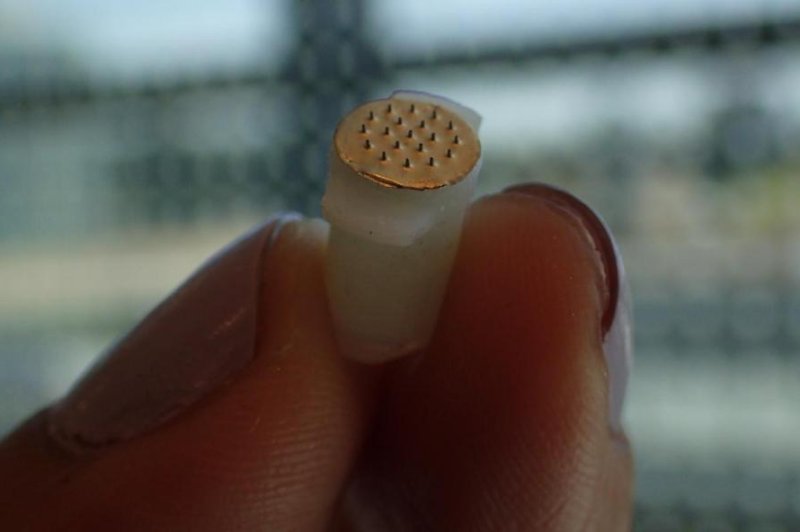Using a microneedle, which is designed to puncture the outer layer of skin, which acts as a protective shield, but not the next layers of epidermis and the dermis, which house nerves, blood vessels and active immune cells, researchers may have created a more comfortable, easier way to monitor drug levels in patients. Photo by Sahan Ranamukhaarachchi/University of British Columbia
VANCOUVER, British Columbia, July 25 (UPI) -- In order to monitor levels of an antibiotic so powerful doctors draw blood from patients multiple times per day, researchers in Canada created a microneedle system to check levels of the drug easily without piercing the skin.
Researchers at the University of British Columbia created a small microneedle patch that measures the drug vancomycin in a patient's system based on concentrations in fluid just below the top layer of skin, making monitoring the drug easier and far less painful for patients and doctors.
Most microneedle devices have been created to deliver drugs to patients, however the new use suggests the technology can offer more than another method of treatment.
Vancomycin is a powerful antibiotic used to treat difficult infections, such as C. difficile, and is delivered intravenously, but doctors draw blood from patients three to four times per day to monitor its levels in the body because it has the potential for life-threatening toxic side effects.
"This is probably one of the smallest probe volumes ever recorded for a medically relevant analysis," Dr. Urs Hafeli, an associate professor of pharmaceutical sciences at the University of British Columbia, said in a press release. "The combination of knowhow from UBC and PSI, bringing together microneedles, microfluidics, optics and biotechnology, allowed us to create such a device capable of both collecting the fluid and performing the analysis in one device."
For the proof-of-concept study, published in the journal Scientific Reports, researchers constructed and tested the device, which consists of an optofluidic device, with a small circle of microneedles to be pressed on the skin for sample collection.
The array of microneedles, which are less than half a millimeter long, is pressed against a patient's skin, drawing a small amount of fluid from beneath the outer layer of skin without puncturing any of those below it. The fluid is then taken up into the device, which causes a chemical reaction that can be detected using an optical sensor, revealing the concentration of vancomycin in a patient's system.
"Many groups are researching microneedle technology for painless vaccines and drug delivery," said Sahan Ranamukhaarachchi, a doctoral student of applied science and pharmaceutical sciences at the University of British Columbia. "Using them to painlessly monitor drugs is a newer idea."















